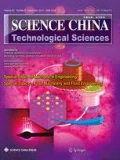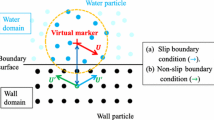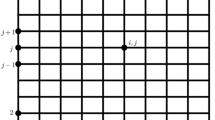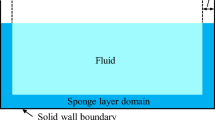Abstract
The large deformations associated with air and water interactions are critical factors that affect the hydrodynamic characteristics of hydraulic structures. As a type of Lagrange meshless particle method, smoothed particle hydrodynamics (SPH) has been shown to have many advantages when modeling the interface flow and tracing the free surface because the particles inherit the velocity, mass, and density properties. Significant theoretical and numerical studies have been performed recently in this area. In the present study, a two-phase SPH framework was developed based on these previous studies and we explored its capacity to capture the main features of large density ratio aerated flows. The cohesive pressure was included only in the momentum equation of the air phase for additional amendments to ensure the stability and accuracy of the two-phase SPH model. Three case studies were performed to test the performance of the two-phase SPH model. A convergence study demonstrated the need to balance the CPU time consumption and the real-time requirements. A dam-break simulation based on pressure variation in the air pocket showed the superior analytical performance of the two-phase model compared with the single-phase model. The results of a hydraulic jump simulation were compared with the theoretical results in order to understand the collision between the solid and liquid using the SPH method more clearly. Thus, the consistency between the simulation and the theoretical and experimental results demonstrated the feasibility and stability of the two-phase SPH framework.
Similar content being viewed by others
References
Hirt C W, Nichols B D. Volume of fluid (VOF) method for the dynamics of free boundaries. J Comput Phys, 1981, 39: 201–225
Monaghan J J. Simulating free surface flows with SPH. J Comput Phys, 1994, 110: 339–406
Liu G R, Liu M B. Smoothed particle hydrodynamics: A meshfree particle method. World Scientific, London, 2003
Lucy L B. A numerical approach to the testing of the fission hypothesis. Astron J, 1977, 82: 1013–1024
Gingold R A, Monaghan J J. Smoothed particle hydrodynamics -theory and application to non-spherical stars. Mon Not R Astron Soc, 1977, 181: 375–389
Monaghan J J. Gravity currents and solitary waves. Physica D, 1996, 98: 523–533
Monaghan J J. SPH compressible turbulence. Mon Not R Astron Soc, 2002, 335: 843–852
Monaghan J J. Smoothed particle hydrodynamics. Annu Rev Astron Astr, 1992, 30: 543–574
López D, Marivela R, Garrote L. Smoothed particle hydrodynamics model applied to hydraulic structure: a hydraulic jump test case. J Hydraul Res, 2010, 48: 142–158
Faltinsen O M, Landrini M, Greco M. Slamming in marine applications. J Eng Math, 2004, 48: 187–217
Sun J W, Liang S X, Sun Z C, et al. A Two-phase simulation of wave impact on a horizontal deck based on SPH method. J Mar Sci Appl, 2010, 9, 372–378
Colagrossi A, Landrini M. Numerical simulation of interfacial flows by smoothed particle hydrodynamics. J Comput Phys, 2003, 191: 448–475
Chen Z, Zong Z, Liu M B, et al. An SPH model for multiphase flows with complex interfaces and large density differences. J Comput Phys, 2015, 283: 169–188
Zhang M, Deng X L. A sharp interface method for SPH. J Comput Phys, 2015, 302: 469–484
Wang Z B, Chen R, Wang H, et al. An overview of smoothed particle hydrodynamics for simulating multiphase flow. Appl Math Model, 2016, 40: 9625–9655
Monaghan J J, Kos A M. Solitary waves on a cretan beach. J Waterw Port C-ASCE, 1999, 125: 145–154
Crespo A J C, Dominguez J M, Rogers B D,et al. DualSPHysics: open-source parallel CFD solver based on smoothed particle hydrodynamics (SPH). Comput Phys Commun, 2015, 187: 204–216
Molteni, D., Colagrossi, A. A simple procedure to improve the pressure evaluation in hydrodynamic context using the SPH. Comput Phys Commun, 2009, 180: 861–872
Nugent S, Posch H A. Liquid drops and surface tension with smoothed particle applied mechanics. Phys Rev E, 2000, 64: 4968–4975
Mokos A, Rogers B D, Stansby P K, et al. Multiphase SPH modelling of violent Hydrodynamics on GPUs. Comput Phys Commun, 2015, 196: 304–316
Shao S. Incompressible smoothed particle hydrodynamics simulation of multifluid flows. Int J Numer Meth Fl, 2012, 69: 1715–1735
Issa R, Lee E S, Violeau D, et al. Incompressible separated flows simulations with the smoothed particle hydrodynamics gridless method. Int J Numer Meth Fl, 2004, 47: 1101–1106
Monaghan J J. On the problem of penetration in particle methods. J Comput Phys, 1989, 82: 1–15
Jiao P G, Zhou Y Q, Li Z R, et al. Simulation of two phase flow using smooth particle hydrodynamics. IEEE KAM 2008 Workshop. Wuhan: IEEE, 2009. 296–300
Verlet L. Computer “experiments” on classical fluids. I. Thermodynamical properties of Lennard-Jones molecules. Health Phys, 1967, 159: 98–103
Zhang A M, Sun P N, Ming F R. An SPH modeling of bubble rising and coalescing in three dimensions. Comput Method Appl M, 2015, 294: 189–209
Gomez-Gesteira M, Rogers B D, Crespo A J C, et al. SPHysics–development of a free-surface fluid solver–Part 1: Theory and formulations. Comput Geosci-UK, 2012, 48: 289–299
Gomez-Gesteira M, Rogers B D, Dalrymple R A, et al. State-of-theart classical SPH for free-surface flows. J Hydraul Res, 2009, 48: 6–27
Zhou Z Q, Kat J O D, Buchner B. A nonlinear 3-D approach to simulate GREEN WATER dynamics on deck. In: Proceeding of the 7th International Conference on Numerical Ship Hydrodynamics, Nantes: 1999
Jonsson P, PÄR Jonsén P, Andreasson P, et al. Smoothed particle hydrodynamics modeling of hydraulic jumps. International Conference on Particle-based Methods–Fundamentals and Applications, 2011, 97: 373–379
Chanson H. Hydraulics of open channel flow, 2nd ed. Oxford, London, 2004
Liu Z W, Chen Y C, Zhu D J. Study on the concentration distribution in a trapezoidal open-channel flow with a side discharge. Environ Fluid Mech, 2007, 7: 509–517
Author information
Authors and Affiliations
Corresponding authors
Rights and permissions
About this article
Cite this article
Yang, H., Li, R., Lin, P. et al. Two-phase smooth particle hydrodynamics modeling of air-water interface in aerated flows. Sci. China Technol. Sci. 60, 479–490 (2017). https://doi.org/10.1007/s11431-016-0586-5
Received:
Accepted:
Published:
Issue Date:
DOI: https://doi.org/10.1007/s11431-016-0586-5




